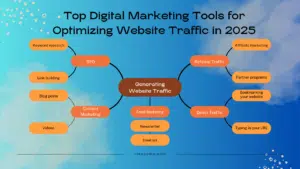Hi, I’m Nisa! As a digital marketer, I know that SEO (Search Engine Optimization) is one of the most crucial aspects of any successful digital marketing strategy. In 2025, with increasing competition online, it’s more important than ever for businesses to optimize their websites and content to rank higher in search engine results. In this article, I’ll cover the best practices for SEO that can help improve your website’s visibility, drive organic traffic, and boost conversions.
1. Conduct Thorough Keyword Research
Keyword research is the foundation of SEO. Without understanding what your audience is searching for, you can’t create content that ranks effectively in search engines.
Why it matters:
- Keyword research helps you identify the terms and phrases that people are using to find products, services, or information related to your business.
- Targeting the right keywords ensures that your content matches the intent behind search queries, improving your chances of ranking high in search engine results pages (SERPs).
How to leverage this strategy:
- Use keyword research tools like Google Keyword Planner, SEMrush, and Ahrefs to find relevant keywords for your business.
- Focus on long-tail keywords (phrases with 3+ words) that have lower competition but are highly relevant to your niche.
- Analyze search volume, keyword difficulty, and competition to choose the best keywords to target.
2. Optimize On-Page SEO
On-page SEO refers to optimizing individual web pages to rank higher and earn more relevant traffic in search engines. It involves a variety of elements, such as content optimization, HTML tags, and URL structure.
Why it matters:
- Proper on-page SEO ensures that search engines can easily understand the context and relevance of your content.
- It improves user experience by making your content more accessible and easy to read.
How to leverage this strategy:
- Title Tags and Meta Descriptions: Include your target keyword in the title tag and meta description, ensuring they are descriptive and enticing for users.
- Headers (H1, H2, H3, etc.): Use headings to structure your content logically, incorporating relevant keywords.
- Image Alt Text: Ensure that your images are optimized for search engines by adding relevant alt text that describes the image using keywords.
- URL Structure: Keep your URLs short, descriptive, and keyword-rich.
3. Create High-Quality, Valuable Content
High-quality content is crucial for SEO. Google’s algorithm prioritizes content that answers user queries, is comprehensive, and provides value to the reader.
Why it matters:
- Content that provides real value to users is more likely to rank well, attract backlinks, and be shared on social media.
- Google’s E-A-T (Expertise, Authoritativeness, Trustworthiness) guidelines mean that well-researched, informative, and relevant content is more likely to rank higher.
How to leverage this strategy:
- Write comprehensive content that thoroughly answers the questions your audience is asking. Aim for long-form content (1,500 words or more) for in-depth coverage.
- Use multimedia such as images, videos, and infographics to make your content more engaging and accessible.
- Update old content: Regularly refresh older blog posts and articles to keep them current and improve their SEO performance.
4. Improve Website Speed and Mobile-Friendliness
Website speed and mobile optimization are critical ranking factors in SEO. With Google’s shift to mobile-first indexing, websites that are mobile-friendly and load quickly will have an advantage in search rankings.
Why it matters:
- A slow website negatively impacts user experience, increasing bounce rates and lowering conversion rates.
- Google uses mobile optimization as a ranking factor, so if your website isn’t mobile-friendly, you risk losing visibility in search results.
How to leverage this strategy:
- Use Google PageSpeed Insights to analyze and improve your website’s load time.
- Optimize images by compressing them without losing quality to improve website speed.
- Implement responsive design to ensure your website looks great on all screen sizes.
- Minimize JavaScript and CSS to reduce website load times and enhance performance.
5. Focus on User Experience (UX)
User experience (UX) is a critical aspect of SEO. Google aims to provide the best results for its users, and websites that offer a positive experience are more likely to rank well.
Why it matters:
- Websites that are easy to navigate and provide clear information lead to better engagement, which indirectly improves SEO performance.
- Google’s Core Web Vitals focus on three key metrics: loading performance, interactivity, and visual stability. These factors contribute to a positive UX and are taken into account for rankings.
How to leverage this strategy:
- Ensure your website’s navigation is simple and intuitive, making it easy for users to find what they need.
- Use clear calls to action (CTAs) to guide users toward desired actions, such as making a purchase or filling out a contact form.
- Make sure your content is easy to read, with proper spacing, font size, and contrast.
6. Build High-Quality Backlinks
Backlinks (links from other websites pointing to your pages) are one of the most important ranking factors for SEO. Quality backlinks from authoritative websites signal to Google that your content is valuable and trustworthy.
Why it matters:
- Backlinks are a vote of confidence from other websites, helping to establish your authority and credibility.
- Referral traffic from backlinks can drive more visitors to your website and increase brand visibility.
How to leverage this strategy:
- Guest blogging: Write guest posts for reputable websites in your industry and include backlinks to your content.
- Influencer outreach: Collaborate with influencers or industry leaders to earn backlinks from their websites or social media profiles.
- Content promotion: Share your content through email outreach, social media, or industry forums to encourage other websites to link to it.
7. Optimize for Local SEO
If your business serves a specific geographic area, local SEO is crucial for improving your visibility in search results. Optimizing for local searches helps you connect with customers who are nearby and actively looking for your products or services.
Why it matters:
- Local searches often result in higher conversion rates, as users are looking for businesses in their area.
- Google uses Google My Business (GMB) profiles to display local search results in the Local Pack, which significantly increases visibility.
How to leverage this strategy:
- Claim and optimize your Google My Business (GMB) profile, ensuring that your business name, address, phone number (NAP), hours, and website are accurate and up-to-date.
- Collect and respond to customer reviews to improve your local credibility and SEO rankings.
- Create location-specific content that targets the local audience, including local keywords and references to local landmarks or events.
8. Track and Analyze Your SEO Performance
Measuring the success of your SEO efforts is essential to ensuring you’re on the right path. Using analytics tools allows you to track your rankings, monitor traffic, and assess your website’s overall performance.
Why it matters:
- Data-driven decisions allow you to understand which SEO strategies are working and which areas need improvement.
- Regular analysis helps you adapt your SEO tactics to keep up with algorithm updates and changing trends.
How to leverage this strategy:
- Use Google Analytics to track website traffic, conversion rates, and bounce rates.
- Monitor keyword rankings with tools like SEMrush or Ahrefs to gauge SEO performance.
- Regularly audit your website’s performance with Google Search Console to identify issues like crawl errors or indexing problems.
Mastering SEO for Digital Marketing Success
In 2025, SEO continues to be an essential part of any digital marketing strategy. By implementing best practices such as thorough keyword research, on-page optimization, content creation, backlink building, and focusing on user experience, you can boost your website’s rankings and attract high-quality traffic.
SEO is not a one-time effort—it requires consistent optimization, monitoring, and adapting to keep up with evolving search engine algorithms. With the right strategies in place, SEO can help you drive organic traffic, improve brand visibility, and achieve long-term business growth.
FAQs about SEO:
What is the difference between on-page and off-page SEO?
On-page SEO refers to the optimization techniques that are implemented directly on a website, such as optimizing meta tags, content, and URL structure. Off-page SEO, on the other hand, refers to activities that take place outside of the website, such as building backlinks and social media marketing.
How long does it take to see results from SEO efforts?
The timeframe for seeing results from SEO efforts can vary depending on a number of factors, such as the competitiveness of the keywords being targeted, the current state of the website’s SEO, and the strategies being used. Generally, it can take anywhere from a few weeks to several months to see significant improvements in search engine rankings and traffic.
Is it necessary to hire an SEO professional for my business?
While it is possible for businesses to handle their own SEO, hiring an experienced SEO professional can provide many benefits. They can provide expertise in optimizing a website, identifying opportunities for improvement, and staying up to date with the latest trends and best practices.
How often should I update my website’s SEO strategy?
SEO is an ongoing process, so it is important to regularly review and update your website’s SEO strategy. This can involve making adjustments to keyword targeting, content optimization, and backlink-building strategies, as well as keeping up with changes in search engine algorithms.
Can social media activity impact SEO?
Can social media activity impact SEO? While social media activity itself does not directly impact SEO, it can indirectly influence search engine rankings. Social media can help increase brand visibility, drive traffic to a website, and potentially generate backlinks, all of which can have a positive impact on SEO.




